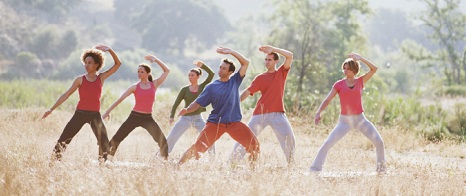Think: calm. Think: flexibility. Think: steady breathing. Think about energy flowing through you, around you, within you. Think about connecting your feet to the earth and your hands with the cosmos. Think about the ancient practice of Tai Chi. Now think about practicing Tai Chi in your contemplative garden space.
Tai Chi is a mainstay of class listings at many botanical gardens, but you don’t have to have a grand or professionally landscaped space to reap the benefits of this ancient Chinese contemplative practice.
Tai Chi is often called “meditation in motion.” The mind-body connection and flow of energy remains consistent throughout the practice. The energy is called “Qi,” (pronounced “chee”), and is made up of two different qualities: Yin (solid, dark, cold, passive) and Yang (light, warm, active). The concept of yin and yang—two opposites working together, or soft movements overcoming hard movements—is central to the practice of Tai Chi. Movements are geared toward absorbing and transferring energy. Tai Chi is a whole body spiritual practice that melds the two parts of Qi, the Yin and the Yang together.
The exchange of energy between internal and external forces is amplified when you practice Tai Chi in the garden, as opposed to doing so in an empty room. When you practice Tai Chi in the garden, you’re also adding another dimension—connecting with mother nature and the living beings that surround you. In the garden, the sights, smells, sounds, and gentle touches of a passing breeze or plant waving in the wind remind you that there are other energies coming into contact with your own. As you calmly proceed through the Tai Chi movements, you practice the art of responding to energy directed your way, and allowing it to flow around you. Sounds like a good skill for life, right?
Tai Chi Movements
All Tai Chi practices involve series of postures (poses) linked together so that the practitioner remains in continuous motion. These postures help to keep one’s Qi, or life force, flowing and moving. Qi keeps the chakras open and spinning in the right direction to provide energy and spiritual connection.
The flow of energy around and through you as you move through the postures is as important as the movements themselves. Throughout your practice you will engage your breath, your muscles, and your thoughts.
Your breath is your center. When you breathe in, think of your self as taking in the energy around you. On an exhale, you’re letting energy out into the universe around you. Typically, you’ll want to take long, slow breaths with an exhale slightly longer than an inhale, and without pause between breaths. Notice your breaths as you move between postures. If there’s a quick transition, quick breaths can ease your movement.
A common Tai Chi sequence has 24 postures. Many of the postures are named after animals and have meanings symbolic of moving through time, earth, the sea, the land, and the air. “Stork Spreads Its Wings” calls to mind a bird flying low over the water, one wing higher than the other. It symbolizes longevity and communication with divinity.
Here are some of the movements and ways they help you connect to the energy around you.
Stork Spreads Its Wings (Also known as “White Crane Spreads Its Wings”
You start with both hands pointing up and to the right. You turn your right toe in, bring the right arm down, and shift your weight to your right foot with your left leg slightly pointed out. The right arm is pointing down, across your body. The left is angled across your body with the back of the hand toward the side of your face. You’ll bend your right arm and bring it in front of the left with the back of the right hand toward the left side of your face. Keeping your weight over the center of gravity you will open both arms, like a crane opening its wings. The right hand pushes up toward the sky and the left hand pushes down toward the ground.
This posture focuses on a direct line of energy running through the feet and hands, extending outward beyond the body. In this way, you breathe and move as to connect with the environment around you.
Needle at Sea Bottom
You begin this posture with a staggered stance, the right leg back and right arm up, left leg forward and arm down. You’ll shift your weight forward, closing your step and pulling the right arm back. The left arm will shift up. Move the left leg forward and fold slightly at the waist, bending knees, and sinking down with the right arm coming forward again (as if reaching for a needle at the bottom of the sea).
This posture symbolizes a transformation of human destiny and discovery of wisdom and creativity. In a sense, a spiritual awakening.
Wave Hands Like Clouds
To complete this posture, stand with weight evenly distributed on both feet, knees slightly bent. You will transfer energy between the feet as you move, pushing off on the left foot, and straightening the leg, which results in more of a bend of the right knee, and so forth. You’ll start with the right arm outstretched in a flat plane with your body, palm down. Your right leg is slightly bent at the knee, As you drop the right arm, you will push off with your right leg, transferring energy from one side of the body to the other. You’ll sweep the right arm in front of your body. As the arm raises to the left side, you’ll rotate your arm so that your palm is facing up. It will pass in front of your face on its way to the original starting position. You will do this with your left hand, as well, and in time, will learn to move the entire body together in harmony.
The symbolism of this posture is bringing order out of confusing, calming the mind. It symbolizes no beginning and no end, but a feeling of continuity.
Spiritual Benefits of Practicing Tai Chi
Tai chi is a contemplative practice that facilitates movement of energy. Practicing Tai chi is a way to move energy and clear out negative thoughts or disrupt cycles of negative thoughts. Relaxing and focusing on putting the mind, breath, and physical movements together eliminates room for stress and anxiety and opens up one to spiritual growth.
Benefits of Practicing Tai Chi in the Garden
Spending time in nature, in the garden, has well-documented benefits. A 2015 study published by the National Academy of Sciences indicates that a 90 minute walk in a natural setting produced a substantial reduction of harmful thought processes detrimental to mental health. A 2009 study of the Japanese practice of “forest bathing,” called Shinrin-Yoku, showed decreased anxiety, depression, and anger, that could potentially lead to increased immune function. The practice has been part of public health initiatives since the 1980s, with well-funded research to back up the positives of spending time in nature.
Try moving your Tai Chi practice to the garden and you will marry the benefits of movement, meditation, and spending time in nature all together.
© Rita Perea, 2016
Tags: Contemplative Gardens, Garden Speaker, Garden Writer, International Contemplative Garden Association, Mindful Garden Practices, Mindfulness, Rita Perea, Tai Chi








